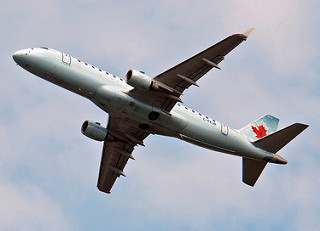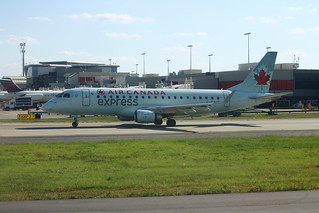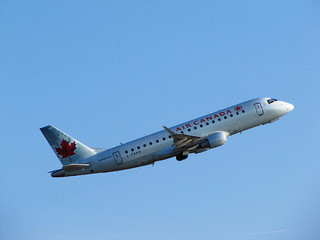Sky Regional DH8D at Toronto on Oct 3rd 2014, figure skating while landing
Last Update: January 11, 2017 / 17:08:03 GMT/Zulu time
Incident Facts
Date of incident
Oct 3, 2014
Classification
Incident
Airline
Sky Regional Airlines
Flight number
RS-7519
Departure
Montreal, Canada
Destination
Toronto City, Canada
Aircraft Registration
C-FSRN
Aircraft Type
De Havilland Dash 8 (400)
ICAO Type Designator
DH8D
Airport ICAO Code
CYTZ
The Canadian TSB complained that although the occurrence happened on Oct 3rd 2014 the TSB was not notified until Oct 31st 2014.
On Jan 11th 2017 the TSB released their final report concluding the probable causes of the occurrence (the TSB did not state, whether the occurrence was rated incident, serious incident or accident):
Findings as to causes and contributing factors
- During the landing roll, the flight crew did not adhere to the normal landing standard operating procedures (nosewheel de-rotation, position of power levers). In addition, only light braking was initially applied. As a result, the flight crew had difficulty slowing the aircraft in a timely manner and a runway overrun nearly occurred.
Findings as to risk
- If operators do not provide adequate simulator training for flight crews to recognize an unstable approach, then there is a risk that flight crews will continue an approach when it is unstable, which may lead to a landing incident.
- If flight crews operate directional control systems outside the manufacturer’s recommendations, then there is a risk that difficulties in directional control may occur.
- If an air operator’s safety management system does not include mandatory reporting of unstable approaches, then there is a risk that the practice will continue without being detected or monitored, which may increase the likelihood of an incident occurring.
- If cockpit voice recordings are not available to an investigation, the identification and communication of safety deficiencies to advance transportation safety may be precluded.
The TSB reported the crew performed an ILS/DME approach to runway 26, intercepted localizer and 4.8 degrees glideslope while at 3000 feet about 5.8nm from the runway threshold, Vapp had been computed at 120 KIAS. The autopilot was disconnected when the aircraft intercepted the glidepath. About 1.9nm from the runway threshold and descending through 1200 feet the crew transitioned from the instrument glideslope (4.8 degrees glidepath) to the visual glidepath (3.3 degrees) using their Headup Guidance System (HGS). At 580 feet AGL the aircraft established on the visual glidepath at 119 KIAS at about 1300 fpm rate of descent and descended through 500 feet AGL at a rate of descent of 1200 fpm - the stabilized approach criteria required a maximum rate of descent of 1000 fpm. The aircraft achieved a stabilized approach at about 250 feet AGL, descending through 180 feet AGL at 120 KIAS and 700 fpm, subsequently crossed the runway threshold at 7 feet AGL at 118 KIAS with the power levers above flight idle. The aircraft touched down about 770 feet past the runway threshold at +1.2G, the aircraft bounced for a second, the power levers were reduced but still remained about flight idle 970 feet past the runway threshold, about 2 seconds later the power levers were moved aft the flight idle but not into the DISC detent, engine torque reduced to 0% about 1360 feet past the threshold with 2628 feet of runway remaining. The nose gear touched down 7.2 seconds after the second touch down of main gear, the airspeed was 90 KIAS at that point 2310 feet past the threshold. 2640 feet past the threshold with 1348 feet of runway remaining the aircraft still travelled at 83 KIAS with brakes pressure at 500 psi (maximum 3000 psi), 1040 feet before the runway end the brakes pressure increased to 1100 psi, airspeed was 74 KIAS, 720 feet before the runway end the power levers reached the maximum reverse position, airspeed was 57 KIAS. The pilot flying operated the nose wheel steering wheel attempting to steer the aircraft onto taxiway A, the nose wheel however began to caster. Maximum brakes (3000psi) was applied, the aircraft began to deviate to the right of the runway center line, speed over ground was 53 knots. The aircraft continued to turn right (290 degrees with runway at 262 degrees) and began exiting the runway at taxiway A at 21 knots over ground, both pilots briefly applied right hand brakes only as the aircraft continued to turn right (302 degrees) at 15 knots over ground. The aircraft then taxied along taxiway A for less than a minute before coming to a full stop to re-engage the steering control handle.
The TSB analysed that the approach went normal during the initial stages. The TSB then analysed:
The aircraft was well above the desired approach path at the operator’s 500-foot stabilization height. In addition, the sink rate was not stable and exceeded the stabilized approach criteria. As a result, the approach was not considered stabilized according to the company’s SOPs.
...
After touchdown, the control column was pulled aft, contrary to the SOPs. This delayed the nosewheel ground contact (7 seconds after the main wheels). In addition, the power levers were not brought to the DISC detent until the nose gear touched the runway. The aft movement of the control column suggests that the nosewheel was intentionally held off the runway. The soft main wheel touchdown, delay in moving the power levers aft, and late nosewheel touchdown suggest that the pilot flying was attempting to perform a smooth landing.
Metars:
CYTZ 032249Z AUTO 16011KT 9SM BKN021 BKN029 OVC036 18/17 A2954 RMK SLP004 DENSITY ALT 1100FT=
CYTZ 032200Z AUTO 17012G17KT 9SM OVC036 18/17 A2955 RMK SLP007 DENSITY ALT 1100FT=
CYTZ 032140Z AUTO 17012G18KT 9SM FEW021 OVC032 18/17 A2955 RMK SLP007 DENSITY ALT 1100FT=
CYTZ 032135Z AUTO 17013G18KT 6SM -RA BR FEW021 SCT026 BKN034 OVC043 18/17 A2955 RMK SLP007 DENSITY ALT 1100FT=
CYTZ 032130Z AUTO 17015KT 5SM -RA BR FEW021 BKN028 BKN036 OVC045 18/17 A2955 RMK SLP008 DENSITY ALT 1100FT=
CYTZ 032128Z AUTO 17015KT 5SM BR FEW021 BKN028 BKN036 OVC045 18/17 A2955 RMK SLP008 DENSITY ALT 1100FT=
CYTZ 032124Z AUTO 17012G17KT 7SM FEW021 BKN029 BKN039 OVC047 18/17 A2956 RMK SLP009 DENSITY ALT 1100FT=
CYTZ 032121Z AUTO 17010KT 6SM -RA BR SCT021 SCT027 BKN041 OVC049 18/17 A2956 RMK SLP009 DENSITY ALT 1100FT=
CYTZ 032117Z AUTO 17011KT 5SM -RA BR SCT021 SCT027 OVC046 18/17 A2955 RMK SLP008 DENSITY ALT 1000FT=
CYTZ 032100Z AUTO 17008KT 7SM -RA FEW031 BKN048 OVC060 18/17 A2956 RMK SLP009 DENSITY ALT 1100FT=
CYTZ 032056Z AUTO 17009KT 6SM -RA BR FEW033 BKN048 OVC060 18/17 A2956 RMK SLP009 DENSITY ALT 1100FT=
CYTZ 032039Z AUTO 18010KT 5SM -RA BR BKN033 BKN042 OVC060 18/17 A2957 RMK SLP012 DENSITY ALT 1100FT=
CYTZ 032000Z AUTO 19011KT 6SM -RA BR FEW031 SCT060 OVC074 18/17 A2957 RMK SLP014 DENSITY ALT 1000FT=
CYTZ 031954Z AUTO 19008KT 6SM -RA BR SCT034 OVC075 18/17 A2957 RMK SLP014 DENSITY ALT 1000FT=
CYTZ 031901Z AUTO 21015G22KT 5SM -RA BR OVC044 19/17 A2959 RMK SLP020 DENSITY ALT 1100FT=
CYTZ 031900Z AUTO 20015G22KT 6SM -RA BR OVC044 19/17 A2959 RMK SLP020 DENSITY ALT 1100FT=
CYTZ 031829Z AUTO 17010G18KT 9SM -RA BKN050 OVC065 20/16 A2958 RMK PRESRR SLP018 DENSITY ALT 1300FT=
CYTZ 031800Z AUTO 12011G18KT 9SM OVC065 21/16 A2957 RMK SLP012 DENSITY ALT 1300FT=
CYTZ 031700Z AUTO 08010G15KT 9SM FEW070 20/16 A2961 RMK SLP028 DENSITY ALT 1200FT=
Incident Facts
Date of incident
Oct 3, 2014
Classification
Incident
Airline
Sky Regional Airlines
Flight number
RS-7519
Departure
Montreal, Canada
Destination
Toronto City, Canada
Aircraft Registration
C-FSRN
Aircraft Type
De Havilland Dash 8 (400)
ICAO Type Designator
DH8D
Airport ICAO Code
CYTZ
This article is published under license from Avherald.com. © of text by Avherald.com.
Article source
You can read 2 more free articles without a subscription.
Subscribe now and continue reading without any limits!
Read unlimited articles and receive our daily update briefing. Gain better insights into what is happening in commercial aviation safety.
Send tip
Support AeroInside by sending a small tip amount.
Related articles
Sky Regional E175 at Toronto on Jan 28th 2019, rejected takeoff due to runway incursion by snow ploughs
A Sky Regional Airlines Embraer ERJ-175, registration C-FEJB performing flight RS-7665 from Toronto,ON (Canada) to Dallas Ft. Worth,TX (USA), was…
Sky Regional E175 near Toronto on Jan 17th 2020, park brake set indication in flight
A Sky Regional Embraer ERJ-175, registration C-FEJD performing flight RS-7531 from New York La Guardia,NY (USA) to Toronto,ON (Canada) with 80 people…
Sky Regional E175 near Montreal on Oct 5th 2019, hydraulic leak
A Sky Regional Airlines Embraer ERJ-175, registration C-FEJB performing flight RS-7590 from Chicago O'Hare,IL (USA) to Montreal,QC (Canada) with 71…
Sky Regional E175 near Halifax on Oct 6th 2019, park brakes not released indication in flight
A Sky Regional Embraer ERJ-175, registration C-FXJF performing flight RS-7558 from Montreal,QC to Halifax,NS (Canada) with 80 people on board, was…
Sky Regional E175 at Chicago on Aug 8th 2019, tail strike on landing
A Sky Regional Airlines Embraer ERJ-175, registration C-FEKD performing flight RS-7611 from Toronto,ON (Canada) to Chicago O'Hare,IL (USA) with 71…
Newest articles
Southwest B737 at Panama City on Jun 14th 2025, turbulence injures passenger
A Southwest Airlines Boeing 737-700, registration N969WN performing flight WN-3508 from Dallas Love,TX to Panama City,FL (USA) with 142 passengers…
Jetblue A320 near Tampa on Oct 30th 2025, inflight upset causes injuries
A Jetblue Airbus A320-200, registration N605JB performing flight B6-1230 from Cancun (Mexico) to Newark,NJ (USA), was enroute at FL350 about 70nm…
Subscribe today
Are you researching aviation incidents? Get access to AeroInside Insights, unlimited read access and receive the daily newsletter.
Pick your plan and subscribePartner

ELITE Simulation Solutions is a leading global provider of Flight Simulation Training Devices, IFR training software as well as flight controls and related services. Find out more.
SafetyScan Pro provides streamlined access to thousands of aviation accident reports. Tailored for your safety management efforts. Book your demo today
AeroInside Blog
Popular aircraft
Airbus A320Boeing 737-800
Boeing 737-800 MAX
Popular airlines
American AirlinesUnited
Delta
Air Canada
Lufthansa
British Airways






